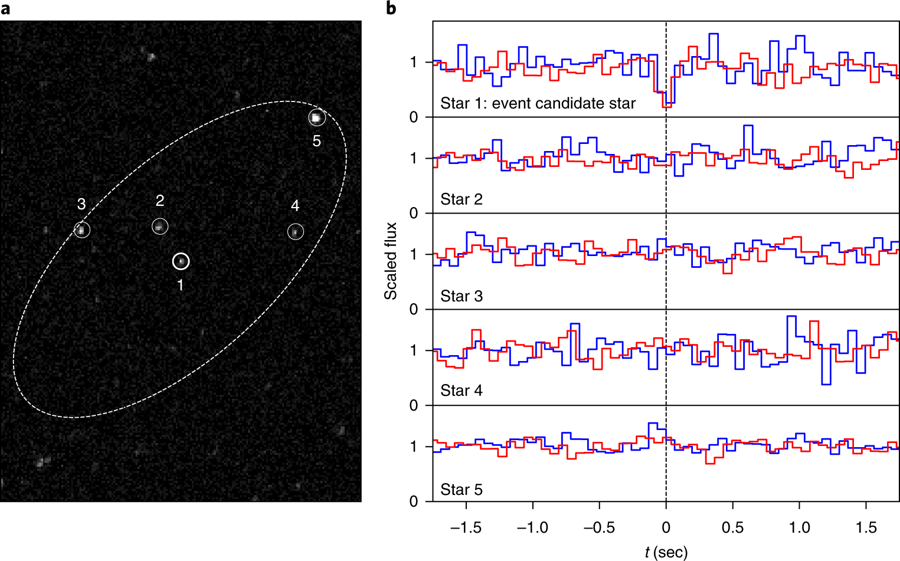アマチュア向け望遠鏡を用い掩蔽によって発見されたキロメートルサイズのカイパーベルト天体
A kilometre-sized Kuiper belt object discovered by stellar occultation using amateur telescopes
2019年1月28日 Nature Astronomy 3 : 1 doi: 10.1038/s41550-018-0685-8

カイパーベルト天体(KBO)は初期の太陽系の生き残りであると考えられ、それらのサイズ分布は太陽系外縁部の形成と進化を研究する機会をもたらす。特に、キロメートルサイズ(半径が 1〜10 キロメートル)の KBO のサイズ分布は、惑星が形成したときの初期の微惑星の大きさの特徴を示している。これらのキロメートルサイズのKBOは極めて暗く、それらを直接的に検出することは不可能であった。その代わり、掩蔽現象のモニタリングは、これらの小さなKBOを発見する考えられる一つの手法である。しかしこれまで、半径 1〜10 キロメートル のKBOの掩蔽現象に対する観測的な証拠は存在していない。本論文では、半径およそ1.3 キロメートル のKBOによる単一の掩蔽現象の候補を初めて検出したことを報告する これは、市販の相補型金属酸化物半導体(CMOS)カメラを組み合わせた2台の低価格の小型望遠鏡によって同時にもたらされた。この発見から、我々はおよそ1.2 キロメートルを超える半径をもつKBOの表面数密度が1平方度あたりおよそ 6×105であると結論付ける。であると結論付ける。この表面数密度は、半径 1〜2 キロメートル にある超過を特徴をする、理論的なサイズ分布モデルを支持する。これが本当にKBOの発見であるなら、暴走的成長段階より前の微惑星が、始原的な太陽系外縁部においてキロメートルサイズの天体に成長し、現在のカイパーベルトで主要な集団として残っていることが示唆される。
Corresponding Author
Kuiper belt objects (KBOs) are thought to be remnants of the early Solar System, and their size distribution provides an opportunity to explore the formation and evolution of the outer Solar System1,2,3,4,5. In particular, the size distribution of kilometre-sized (radius = 1–10 km) KBOs represents a signature of initial planetesimal sizes when planets form5. These kilometre-sized KBOs are extremely faint, and it is impossible to detect them directly. Instead, the monitoring of stellar occultation events is one possible way to discover these small KBOs6,7,8,9. However, until now, there has been no observational evidence for occultation events of KBOs with radii of 1–10 km. Here, we report the first detection of a single occultation event candidate by a KBO with a radius of ~1.3 km, which was simultaneously provided by two low-cost small telescopes coupled with commercial complementary metal–oxide–semiconductor cameras. From this detection, we conclude that the surface number density of KBOs with radii exceeding ~1.2 km is ~6 × 105 deg−2. This surface number density favours a theoretical size distribution model with an excess signature at a radius of 1–2 km (ref. 5). If this is a true KBO detection, this implies that planetesimals before their runaway growth phase grew into kilometre-sized objects in the primordial outer Solar System and remain as a major population in the present-day Kuiper belt.

